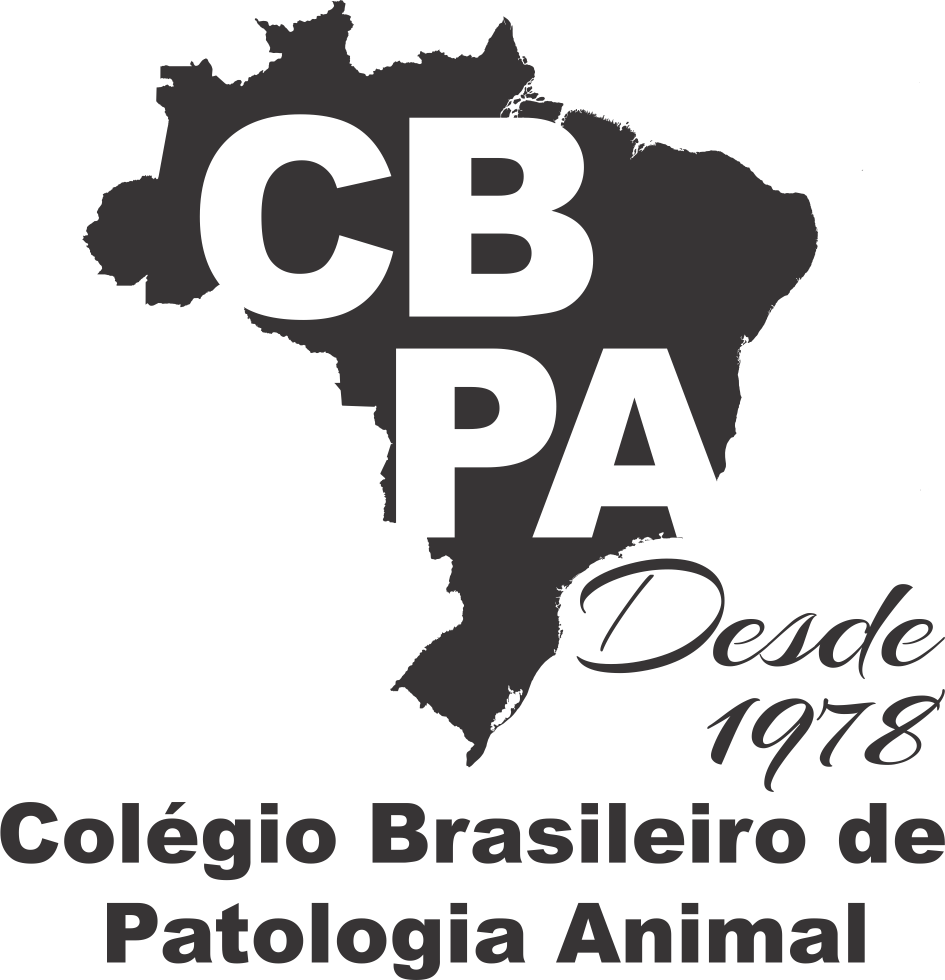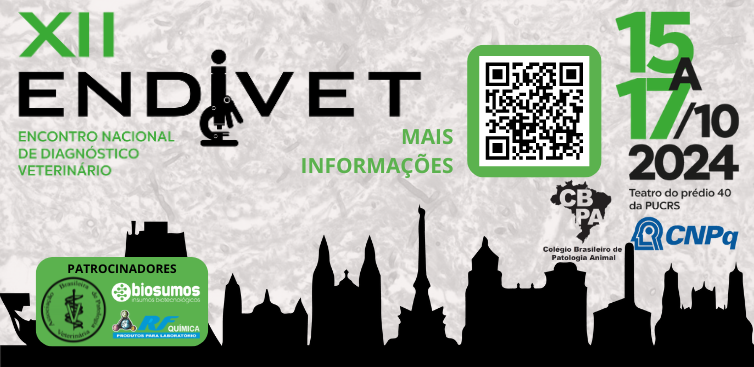Resultado da pesquisa (140)
Termo utilizado na pesquisa p.m.
#1 - Oral metformin for type-2 diabetes mellitus treatment in a black-tufted marmoset (Callithrix penicillata)
Abstract in English:
Type-2 diabetes mellitus (T2DM) is characterized by defects in insulin secretion and combined peripheral resistance to the hormone. Several non-human primates (NHP) species develop T2DM, mainly captive animals with reduced physical activity and incorrect feeding. This case report describes the T2DM treatment of a black-eared marmoset (Callithrix penicillata) by diet reformulation and metformin oral administration. An adult female was diagnosed with T2DM after hyperglycemia and high serum fructosamine associated with glycosuria and obesity. Metformin hydrochloride (125mg/animal, orally, q24h) associated with feeding intervention was started. After 26 days, a significant reduction in weight, glycemia, and serum fructosamine could be observed, showing satisfactory results for the adopted therapy. Metformin is considered a safe drug for T2DM treatment due to its low hypoglycemia risk. The new diet consisted of sweet potato, squash, and varied fruits offered twice daily. In addition, thawed-mice newborns, egg whites, and small portions of pelleted primate food. In the present report, metformin use, associated with a low glycemic index diet, was effective in treating this particular marmoset and may present a potential for T2DM treatment in other NHPs.
Abstract in Portuguese:
Diabetes mellitus tipo 2 (DM2) caracteriza-se por uma combinação de defeitos na secreção de insulina e resistência periférica ao hormônio. Diversas espécies de primatas não humanos (PNH) desenvolvem DM2, sobretudo animais cativos com atividade física reduzida e alimentados incorretamente. Este trabalho descreve o tratamento de DM2 em sagui-de-tufo-preto (Callithrix penicillata), através da reformulação da dieta e administração oral de metformina. Uma fêmea adulta foi diagnosticada com DM2 após apresentar hiperglicemia e frutosaminemia elevadas associadas à glicosúria e à obesidade. Iniciou-se o uso do cloridrato de metformina (125mg/animal, VO, SID) associado ao controle de consumo alimentar com ajustes da dieta. Após 26 dias pode-se observar redução significativa de peso, adequação da glicemia e frutosaminemia, constatando resultado satisfatório da terapêutica adotada. A metformina é considerada um medicamento seguro para o tratamento de DM2, devido ao baixo risco de hipoglicemia. A base da nova dieta era batata-doce, abóbora e frutas variadas oferecidas duas vezes ao dia. Além disso, camundongos recém-nascidos descongelados, clara de ovo e pequenas porções de ração primata peletizada. No presente relato, a metformina associada a uma dieta com baixo índice glicêmico, foi eficaz para tratamento de DM2 podendo apresentar potencial terapêutico de DM2 em outros PNH.
#2 - Main diseases of cattle in the midwestern region of São Paulo state
Abstract in English:
São Paulo state is one of the country’s largest producers of beef and milk, and the midwestern region plays a key role in this production, as half of São Paulo’s cattle herd is found in this region. These numbers alone demonstrate the importance of livestock in this region. Therefore, this study aimed to describe the main epidemiological and clinical signs in cattle cases at the Large Animal Hospital at FMVZ-Unesp, located in the midwestern region of São Paulo state. The present retrospective study assessed 638 clinical cases of cattle treated from January 2010 to December 2019 (10 years). Digestive system diseases were the most prevalent, diagnosed in 30.3% of patients, followed by neurological diseases (19.1%) and respiratory diseases (10.5%). The other diseases were distributed in decreasing order as follows: musculoskeletal (7.8%), hematopoietic (6.1%), genitourinary (5.6%), metabolic and nutritional (5.5%), neonatal (4.7%), cutaneous (2.6%), poisoning (2.5%), lymphatic (2.2%), cardiovascular (1.6%) and other diseases (1.4%). Rabies, a fatal zoonotic disease, was the main cause of death in this study and the main disease associated with neurological signs (23.7%). Recognizing the main diseases of cattle in this region will promote the adoption of prophylactic measures to minimize their occurrence and manage treatment to avoid economic losses and decreased productivity of herds.
Abstract in Portuguese:
O estado de São Paulo é um dos maiores produtores de carne e leite bovino do país e a região centro-oeste do estado tem papel fundamental nessa produção, pois possui a metade do rebanho de bovinos do estado. Portanto, este estudo descreve os principais achados clínicos e epidemiológicos de bovinos atendidos no Hospital de Grandes Animais da FMVZ/Unesp, localizado na região centro-oeste paulista. Foi realizado um levantamento nos arquivos da Clínica de Grandes Animais do Hospital Veterinário da FMVZ-Unesp, Botucatu/SP, dos 638 casos clínicos de bovinos atendidos de janeiro de 2010 a dezembro de 2019. Enfermidades do sistema digestório foram as mais prevalentes (30,3%), seguidas das doenças neurológicas (19,1%) e respiratórias (10,5%). As demais enfermidades foram distribuídas, em ordem decrescente, em: musculoesquelético (7,8%), haematopoiético (6,1%), geniturinário (5,6%), cutânea (2,6%), linfático (2,2%) e cardiovascular (1,6%) ou foram classificadas em doenças metabólicas e nutricionais (5,5%), neonatais (4,7%), tóxicas (2,5%) ou outros distúrbios (1,4%). A raiva, uma zoonose fatal, foi a principal causa de óbito neste estudo e a principal doença neurológica (23,7%). O reconhecimento das principais doenças dos bovinos desta região permite a adoção de medidas profiláticas e de manejo para minimizar sua ocorrência e evitar perdas econômicas com o tratamento e menor produtividade do rebanho.
#3 - Segmental lumbar spinal cord aplasia in a free-ranging southern tiger cat (Leopardus guttulus)
Abstract in English:
We report a case of a free-ranging five-month wildcat with bilateral hind limbs paralysis since birth due to a segmental lumbar spinal cord aplasia. The species confirmation of the southern tiger cat (Leopardus guttulus) was determined by genetic sequencing. This southern tiger cat native to Brazil had autophagy in both pelvic limbs during the initial phase of hospitalization, followed by a right tibial fracture with bone exposition. Euthanasia was chosen due to animal welfare and submitted for postmortem examination. Grossly, there was an 8.5cm in-length segmental interruption of the spinal cord between the third and fifth lumbar vertebrae, with a lack of spinal cord tissue and collapsed associated dura mater. Microscopically, the representative sections of the L3 to L5 spinal cord had only .an irregular trace of gray matter adhered to the meninges (lumbar spinal cord aplasia) In the region of L6, a focally extensive, cystic, and well-defined tubular cavitation was noted dorsally to the central canal, replacing and compressing the adjacent nervous tissue (syringomyelia). Metagenomics examination did not detect any virus responsible for the presented spinal cord malformations. This seems to be the first description of segmental spinal cord aplasia reported in a wild feline.
Abstract in Portuguese:
O objetivo do presente relato foi descrever um caso de aplasia segmentar da medula espinhal lombar em um felino silvestre, com aproximadamente cinco meses, resgatado de seu ambiente natural, apresentando paralisia bilateral dos membros posteriores. A espécie gato-do-mato-pequeno (Leopardus guttulus) foi determinada por sequenciamento genético. Após curto período de hospitalização, iniciou autofagia de ambos os membros pélvicos, seguido de fratura com exposição óssea. Optou-se pela eutanásia e o cadáver foi encaminhado ao Setor de Anatomia Patológica da Universidade Federal Rural do Rio de Janeiro para necropsia. Macroscopicamente, havia uma interrupção segmentar grave da medula espinhal entre a terceira e a quinta vértebras lombares, medindo 8,5cm de comprimento, com resquícios de tecido nervoso e com meninges colapsadas. Ao exame histológico, em seções da medula espinhal na região de L3 a L5, .havia apenas vestígio de tecido nervoso aderido às meninges, morfologicamente compatível com substância cinzenta (aplasia de medula espinhal lombar). Na região de L6 notou-se áreas multifocais com cavitações tubulares, císticas e bem delimitadas, dorsalmente ao canal central substituindo e comprimindo o tecido nervoso adjacente (siringomielia). O exame de metagenômica não detectou qualquer vírus responsável pelas malformações da medula espinhal. Com base no histórico, sinais clínicos, necropsia e achados histológicos, o diagnóstico de aplasia segmentar grave com siringomielia foi estabelecido em um L. guttulus.
#4 - Anatomopathological findings of Testudines necropsied in the Distrito Federal, Brazil
Abstract in English:
In order to determine the main anatomopathological findings of Testudines necropsied in the Distrito Federal, all necropsy records performed at the “Laboratório de Patologia Veterinária” of the “Universidade de Brasília” (LPV-UnB) on Testudines during the period from January 2008 to July 2020 were reviewed. The 72 cases reviewed were grouped and classified according to species, sex, origin, season of occurrence, and diagnosis. In 69.44% of the cases the species was informed in the necropsy protocols, which included Phrynops geoffroanus (38%), Trachemys dorbigni (36%), Chelonoidis carbonaria (14%), Chelonoidis denticulata (10%) and Podocnemis expansa (2%). In 30.55% of the cases this parameter was not informed and were classified only as Testudines. In 41.66% of the cases the sex was informed, being female 22.22%, male 19.44%, and 58.33% were not informed. Of these animals 79.16% were from environmental agencies and 20.84% from zoos and/or guardians. In 70.83% of the animals analyzed they were directly related to the autumn and winter seasons, with June being the most frequent month (29.17%). The conclusive diagnosis was possible in 68.05% of the cases. The category of disorders caused by injurious agents (48.97%) was the most prevalent, followed by inflammatory disorders (32.65%) and nutritional and metabolic disorders (28.57%). The main diagnoses were carapace and/or plastron fracture with 30.61%, hepatic steatosis (20.40%) and pneumonia (10.22%). Most cases of carapace or plastron fracture and hepatic steatosis occurred in animals from environmental agencies.
Abstract in Portuguese:
Com o objetivo de determinar os principais achados anatomopatológicos de Testudines necropsiados no Distrito Federal, foram revisadas todas as fichas de necropsia realizadas no Laboratório de Patologia Veterinária da Universidade de Brasília (LPV-UnB) em Testudines, durante o período de janeiro de 2008 a julho de 2020. Os 72 casos revisados foram agrupados e classificados quanto à espécie, sexo, procedência, estação do ano de ocorrência e diagnóstico. Em 69,44% dos casos havia a espécie informada nos protocolos de necropsia, que incluíam Phrynops geoffroanus (38%), Trachemys dorbigni (36%), Chelonoidis carbonaria (14%), Chelonoidis denticulata (10%) e Podocnemis expansa (2%). Em 30,55% dos casos não tiveram esse parâmetro informado e foram classificados apenas como Testudines. Em 41,66% casos foi informado o sexo, sendo fêmea 22,22%, macho 19,44% e não informados 58,33%. Destes animais 79,16% eram de órgão ambiental e 20,84% de zoológicos e ou tutores. Em 70,83% dos animais analisados tiveram direta relação com as estações de outono e inverno, sendo o mês de junho o mais frequente (29,17%). O diagnóstico conclusivo foi possível em 68,05% dos casos. A categoria de distúrbios causados por agentes lesivos (48,97%) foi a mais prevalente, seguido por distúrbios inflamatórios (32,65%) e dos distúrbios nutricionais e metabólicos (28,57%). Os principais diagnósticos foram fratura de carapaça e ou plastrão com 30,61%, esteatose hepática (20,40%) e pneumonia (10,22%). A maior parte dos casos de fratura de carapaça ou plastrão e de esteatose hepática ocorreram em animais provenientes de órgão ambiental.
#5 - Tracheal post-vaccinal reaction to different strains of Newcastle disease virus
Abstract in English:
The aim of the present study was to evaluate the post-vaccinal reaction to two lentogenic vaccine strains of Newcatle disease virus (NDV) and a recombinant turkey herpesvirus (rHVT) vaccine expressing the fusion glycoprotein of NDV in broiler chickens through histomorphometric and histopathologic analyses of the trachea. The experiment involved 245 chicks housed in randomized blocks with three different enclosures under controlled conditions of temperature, light and ventilation. Each enclosure represented a vaccine strain and was divided into groups according to the administration route. Each block also had its own control group composed of unvaccinated birds. The vaccine strains PHY.LMV.42 (PL42) and La Sota (LS) were selected according to the Intracerebral Pathogenicity Index (ICPI) and the rHVT-NDV Serotype 3 strain (ST3) was selected for representing non-NDV infection. At two, four, seven, 14 and 21 days post vaccination, fragments from the middle third of the trachea were collected and submitted to routine histological processing. For the histomorphometric analysis, the slides were photographed, and the thickness of the tracheal mucosa was measured. Statistical analysis involved two-way ANOVA and Tukey’s post-hoc test with a 5% significance level. For the histopathological evaluation, lesions were described as to the degree of intensity and distribution. At four and 14 days post vaccination with the LS strain administered by the ocular route, the means of thickening of the tracheal mucosa (20.85±7.31µm and 26.97±5.50µm, respectively) were significantly higher (p<0.05) than for all other strains, which was related to the severe histopathological lesions found in this group, characterized by hyperemia, hyperplasia of the mucous glands, moderate deciliation and multifocal lymphohistiocytic inflammatory infiltrate. At 21 days, broiler chickens vaccinated with the ST3 strain showed more discrete lesions and less thickening of the tracheal mucosa (23.23±7.62µm; p<0.05) in comparison with other studied strains. The lesions found in this group were only hemorrhage, deciliation and mild focal lymphocytic inflammatory infiltrate. The results of the histomorphometry and histopathology of the trachea indicated that vaccination with rHVT-NDV Serotype 3 strain induced lower degree post-vaccine tracheal lesions compared to other vaccine strains analyzed in this study.
Abstract in Portuguese:
Objetivou-se avaliar a reação pós-vacinal de duas estirpes lentogênicas do vírus da doença de Newcastle (VDN) e uma vacina recombinante de herpesvirus de perus (rHVT) que expressa a glicoproteína de fusão de VDN em frangos de corte por meio da histomorfometria e histopatologia da traqueia. Foram utilizados 245 pintos alojados em blocos ao acaso, sendo três galpões distintos em condições controladas de temperatura, luz e ventilação. Cada galpão representou uma cepa vacinal, onde foram divididos por grupos de acordo com a via de administração. Todos os blocos possuíam um grupo controle composto por aves não vacinadas. As cepas vacinais PHY.LMV.42 (PL42) e La Sota (LS) utilizadas foram selecionadas de acordo com o Índice de Patogenicidade Intracerebral (IPIC) e a cepa Sorotipo 3 (ST3), da vacina rHVT-VDN foi selecionada por não representar infecção do VDN. Aos dois, quarto, sete, 14 e 21 dias pós-vacinação, fragmentos do terço médio da traqueia foram coletados e posteriormente processados conforme rotina histológica. Para análise histomorfométrica da mucosa traqueal, as lâminas foram fotografadas e realizadas as mensurações da espessura da mucosa traqueal sendo aplicado teste de análise de variância a dois critérios (ANOVA) e utilizando o post-hoc de Tukey com nível de significância de 5%. Para a avaliação histopatológica foram observadas a presença de lesões microscópicas e estas foram descritas quanto ao grau de intensidade e distribuição. Aos quatro e quatorze dias pós-vacinação com a cepa LS administrada por via ocular, as médias do espessamento da mucosa traqueal (20,85±7,31µm e 26,97±5,50µm, respectivamente) foram significativamente maiores (p<0,05) quando comparada a todas as demais cepas utilizadas, isto se deve às severas lesões histopatológicas encontrados neste grupo, caracterizadas por hiperemia, hiperplasia das glândulas mucosas, deciliação moderada e infiltrado inflamatório linfohistiocitário multifocal moderado. Já aos 21 dias as aves vacinadas com a cepa ST3 apresentaram lesões mais discretas e menor espessamento da mucosa da traqueia (23,23±7,62µm; p<0,05) em comparação às demais cepas estudadas. As lesões encontradas neste grupo foram apenas hemorragia, deciliação e infiltrado inflamatório linfocitário focal discreto. Os resultados da histomorfometria e da histopatologia da traqueia indicou que a vacinação com a rHVT-NDV, cepa Sorotipo 3 induziu menor grau de lesões pós-vacinais na traqueia comparada a outras cepas vacinais analisadas nesse estudo.
#6 - Doramectin intoxication in malnourished 15-month-old cattle
Abstract in English:
Macrocyclic lactones are widely used as endectocides in farm animals. Intoxications occur in situations of overdose and/or malnutrition, in young animals, and in genetically sensitive breeds. We describe the intoxication by doramectin in malnourished 15-month-old cattle that received 1.6 times the recommended dose. The animals presented salivation, ataxia, motor incoordination, reluctance to move, and sternal recumbency. Two animals recovered spontaneously; one died and was necropsied. No gross or microscopic changes were observed. This study suggests that doramectin may cause intoxication when administered to malnourished cattle in doses higher than those recommended and that knowing the history is essential to establish a diagnosis.
Abstract in Portuguese:
dectocidas em animais de produção. Casos de intoxicação ocorrem em situações de sobredosagem e/ou desnutrição, em animais jovens ou em raças geneticamente suscetíveis. Descreve-se a intoxicação por doramectina em bovinos desnutridos, com 15 meses de idade, que receberam uma dose 1,6 vezes maior que a dose recomendada. Os animais apresentaram salivação, ataxia, incoordenação motora, relutância em se movimentar e decúbito esternal. Dois animais se recuperaram espontaneamente; um morreu e foi necropsiado. Não foram observadas alterações macro e microscópicas. Esse relato sugere que a doramectina pode causar intoxicação em bovinos desnutridos quando administrada em doses maiores que as recomendadas e que o histórico é fundamental para estabelecer o diagnóstico.
#7 - Taeniasis-cysticercosis complex in the agrarian reform rural settlements, Brazil
Abstract in English:
Thousands of families live in agrarian reform rural settlements, these existing in Brazil since the 1980s. Factors such as agglomerations of families living in the same environment and the production of domestic animals can promote the transmission and maintenance of zoonosis in these areas. The epidemiology and geographic distribution of zoonotic diseases in settlement communities need to be highlighted. The present study aimed to investigate the prevalence, risk factors and spatial distribution of the teniasis-cysticercosis complex in the agrarian reform rural settlements in the state of Minas Gerais. A total of 497 family farming properties, distributed in 52 settlements, were randomly selected and sampled. Biological samples of humans, cattle and pigs were collected and processed. Survey questionnaires were applied in each family farming property to collect data on animal production as well as sanitary, hygienic and social conditions of each family. Human fecal samples were analyzed for detection of teniasis infection, while animal blood samples were collected and subjected to serological testing to detect the cysticercosis infection. A total of three (0.35%) positive cases of human teniasis were identified, 64 (4.2%) of bovine cysticercosis and 17 (3.3%) of swine cysticercosis. Prevalence per family farming unit was 0.6% (3/497) of taeniasis through fecal test, 5.8% (17/294) for swine cysticercosis and 11.1% (52/469) for bovine cysticercosis. The spatial profile for human teniasis and swine cysticercosis were clustered in two different regions, while bovine cysticercosis showed a dispersed geographical distribution. Two risk factors were associated with the occurrence of bovine cysticercosis: stream as source of water (p=0.009) and the environment as destination of sewage (p=0.031), while burning of garbage was shown to be a significant protective factor (p<0.001). Risk factor for swine cysticercosis was associated with the presence of free range pigs (p=0.008) and the environment as the destination of sewage (p≤0.024). The low number of positive human taeniasis did not allow statistical analysis. These zoonotic diseases represent a significant risk to public health because of their occurrence in livestock which are produced for both beef consumption and for commercialization. Significant endemic areas in the state of Minas Gerais have been determined in this study, and these discoverments suggest the importance of further investment in public health education about teniasis-cysticercosis transmission, the improvement of sanitary facilities for the settlements such as source and treatment of water and adequate destination of sewage. Integrated actions between the human, animal and environmental health sectors, at local and regional levels are needed, aiming at the adoption of effective public policies for the control and eradication of the teniasis-cysticercosis complex where the disease occurs.
Abstract in Portuguese:
Milhares de famílias vivem nos assentamentos da reforma agrária, criados no Brasil desde a década de 1980. Fatores como aglomerações de famílias convivendo no mesmo ambiente de produção de animais domésticos podem favorecer a transmissão e manutenção de zoonoses nessas áreas. A epidemiologia e distribuição geográfica das doenças zoonóticas nas comunidades assentadas precisam ser destacadas. Neste sentido, o presente estudo objetivou investigar a prevalência, fatores de risco e distribuição espacial do complexo teníase-cisticercose nos assentamentos rurais da reforma agrária no estado de Minas Gerais. Um total de 497 propriedades da agricultura familiar, distribuídas em 52 assentamentos, foram selecionadas e amostradas aleatoriamente. Amostras biológicas de humanos, bovinos e suínos foram coletadas e processadas. Questionários epidemiológicos foram aplicados em cada propriedade para a coleta de dados sobre a produção animal, condições sanitárias, higiênicas e sociais de cada família. Amostras fecais humanas foram analisadas para detecção de infecção por teníase, e amostras de sangue de animais foram coletadas e submetidas a testes sorológicos para detecção de infecção por cisticercose. Foram encontrados três (0,35%) casos positivos para teníase humana, 64 (4,2%) para cisticercose bovina e 17 (3,3%) para cisticercose suína. A prevalência por unidade de agricultura familiar foi de 0,6% (3/497) para teníase por exame fecal, 5,8% (17/294) para cisticercose suína e 11,1% (52/469) para cisticercose bovina. O perfil espacial da teníase humana e da cisticercose suína agrupou-se em duas regiões distintas, enquanto a cisticercose bovina apresentou distribuição geográfica dispersa. Dois fatores de risco estiveram associados à ocorrência de cisticercose bovina: riacho como fonte de água (p=0,009) e meio ambiente como destino de esgoto (p=0,031), enquanto a queima de lixo mostrou-se um fator de proteção significativo (p<0,001). O fator de risco para cisticercose suína foi associado à presença de suínos caipira (p=0,008) e ao meio ambiente como destino do esgoto (p≤0,024). Estas doenças zoonóticas representam um risco significativo para a saúde pública devido à sua ocorrência em rebanhos que são produzidos tanto para consumo de carne quanto para comercialização. Neste estudo os assentamentos analisados se configuram em áreas endêmicas no estado de Minas Gerais, e esses achados sugerem a importância de maiores investimentos na educação em saúde pública, melhoria das instalações sanitárias dos assentamentos como fonte e tratamento de água e destinação adequada de esgoto. São necessárias ações integradas entre os setores de saúde humana, animal e ambiental, em âmbito local e regional, visando a adoção de políticas públicas efetivas de controle e erradicação do complexo teníase-cisticercose onde estiver presente.
#8 - Prevalence and factors associated with Dirofilaria immitis infection in dogs in Sertão Paraibano, Northeast Brazil
Abstract in English:
Dirofilaria immitis is a heart and large vessel parasite that mainly affects domestic dogs and has shown a re-emerging zoonosis in recent years. The objective of this study was to determine the prevalence, associated factors, and geographic areas of D. immitis in dogs in the city of Sousa, Paraíba, Northeast Brazil. A total of 320 dogs were selected and evaluated, 160 domiciled and 160 wandering, from the 32 districts of the city. Clinical examination, blood collection, and epidemiological data retrieval were performed for each animal. The sanitation conditions of the environment were visually observed at the time of evaluation. Three methods were used to investigate the morphometric diagnosis of microfilariae: capillary blood smear (ESC), peripheral blood smear (ESP), and modified Knott test. The data were subjected to univariate and multivariate statistics for the observation of risk factors and qualitative assessment of the examinations. Of the 17.5% (56/320) of animals testing positive for D. immitis, 25% (40/160) were wandering and 10% (16/160) were domiciled dogs. Positive dogs were found in 24 of the 32 neighborhoods evaluated, with Angelim and Doutor Zezé having the highest percentages of 1.56% (5/320) each. Only the categories of cardiac alterations (OR 6.231 [1,539-25,236]) and stray dogs (OR 2.463 [1,281-4,735]) demonstrated potential risk factors for infection. Of the 56 positive animals, 28 were positive in the three tests, and another 28 showed variance between methods and/or between prepared slides. No other filaridae were observed. The city of Sousa is considered to have a significant prevalence of infection by D. immitis, and forms of control and prophylaxis are required to reduce the risks of transmission to animals, as well as to humans.
Abstract in Portuguese:
Dirofilaria immitis é um parasito de coração e de grandes vasos que acomete principalmente cães domésticos, também causador de uma zoonose reemergente nos últimos anos. O objetivo deste trabalho foi determinar a prevalência, fatores associados e áreas geográficas de D. immitis em cães na cidade de Sousa, Paraíba, Nordeste do Brasil. Para isso, foram selecionados e avaliados 320 cães, sendo 160 domiciliados e 160 errantes, provenientes dos 32 bairros da cidade. Foi realizado o exame clínico, coleta de sangue e dados epidemiológicos de cada animal. O ambiente foi observado visualmente quanto as condições de saneamento no momento de avaliação. Para pesquisa de microfilárias, foram realizados três métodos: esfregaço sanguíneo capilar (ESC), periférico (ESP) e teste de Knott-modificado, associado ao diagnóstico morfométrico das microfilárias. Os dados foram submetidos a estatísticas uni e multivariadas para observação de fatores de risco e avaliação qualitativa dos exames. Obteve-se prevalência de 17,5% (56/320) de animais positivos para D. immitis, sendo 25% (40/160) errantes e 10% (16/160) domiciliados. Dos 32 bairros avaliados, em 24 foram encontrados cães positivos, sendo Angelim e Doutor Zezé, os bairros com maior percentual 1,56% (5/320) cada. Somente as categorias de alterações cardíacas (OR 6,231 [1.539-25.236]) e cães errantes (OR 2,463 [1.281-4.735]) demonstraram potencial fator de risco para infecção. Dos 56 animais positivos, 28 apresentaram positividade nos três testes, e outros 28 demonstraram variância entre métodos e/ou entre lâminas confeccionadas. Não foram observados outros filarídeos. Considerou-se que a cidade de Sousa apresenta prevalência significativa de infecção por D. immitis, sendo necessário estabelecer formas de controle e profilaxia, para reduzir os riscos da transmissão para animais, como também para humanos.
#9 - Quantitative study of wild animals received at the Wild Animals Triage Centers (CETAS) in Bahia and identification of trafficking routes
Abstract in English:
In Brazil, the illegal capture of wild animals is a crime that contributes to the extinction of species, besides causing environmental imbalance and suffering to the animals. Here, we undertook a quantitative survey of animals sent to the “Centro de Triagem de Animais Silvestres” (CETAS - Wild Animals Triage Centers) from units of Porto Seguro, Salvador, and Vitória da Conquista during 2009-2019. The 19,317, 34,460, and 43,874 specimens were registered in the units of Porto Seguro, Vitória da Conquista, and Salvador, respectively. The distribution of the totals by class included 80,948 (82.90%) birds, 12,007 (12.30%) reptiles, 4,661 (4.77%) mammals, and 35 arachnids (0.03%). The operations that generated registration at the CETAS were most frequently apprehensions (67,974; 69.67%), followed by voluntary surrender (13,367; 13.69%), rescues (12,803; 13.11%), and transfers (2,735; 2.67%). The animals came from 236 municipalities in the state of Bahia, with emphasis on the municipalities of Salvador, Vitória da Conquista, Feira de Santana, Lençóis, Jequié, and Paulo Afonso. The evaluation of the quantitative seizures by municipalities indicates that the BR-116 is one of the most representative routes for the illegal traffic of wild animals in the state of Bahia and the country.
Abstract in Portuguese:
No Brasil a captura ilegal de animais silvestres é crime e contribui para a extinção das espécies, além de causar desequilíbrios ambientais e sofrimentos aos animais. Este trabalho apresenta quantitativos de animais recebidos e/ou armazenados nos Centros de Triagem de Animais Silvestres (CETAS) do estado da Bahia, no período de 2009-2019. Os totais de 19.317, 34.460 e 43.874 espécimes foram registrados nas unidades de Porto Seguro, Vitória da Conquista e Salvador, respectivamente. A distribuição dos totais por classe incluiu 80.948 (82,90%) aves, 12.007 (12,30%) répteis, 4.661 (4,77%) mamíferos e 35 aracnídeos. Quanto à natureza da operação que gerou o registro nos CETAS, as mais frequentes foram apreensão (67.974; 69,67%), entrega voluntária (13.367; 13,69%), resgate (12.803; 13,11%) e transferência (2.735; 2,67%). Os animais foram apreendidos em 236 municípios do estado da Bahia, com destaque para Salvador, Vitória da Conquista, Feira de Santana, Lençóis, Jequié e Paulo Afonso. A avaliação dos quantitativos das apreensões por municípios indica que a BR-116 é uma das rotas de escoamento mais representativa do tráfico ilegal de animais silvestres, no estado da Bahia e no país.
#10 - Conidiobolomycosis in goats
Abstract in English:
The present article presents cases of conidiobolomycosis in adult goats with clinical signs characterized by serous nasal discharge, dyspnea, apathy, and weight loss. Two goats were necropsied. Necropsy displayed increased volume on the sagittal section of the head and an ulcerated surface containing a yellow friable mass with irregular and granular consistency in the nasal septum and in the ventral nasal turbinate. One goat also presented lesions on the ear’s skin and the right pelvic limb. Microscopically, lesions were characterized by multifocal granulomas with a central necrotic area containing non-stained fungal hyphae images surrounded by a granulomatous infiltrate. Samples of the lesions examined by immunohistochemistry and polymerase chain reaction were positive for Conidiobolus lamprauges. This is the first report of conidiobolomycosis in goats, and the disease should be considered in the differential diagnoses for rhinitis and dermatitis in goats.
Abstract in Portuguese:
O presente artigo apresenta casos de conidiobolomicose em cabras adultas com sinais clínicos caracterizados por secreção nasal serosa, dispneia, apatia e perda de peso. Dois caprinos foram necropsiados. Na necropsia, em corte sagital da cabeça, foi observado aumento de volume e superfície ulcerada contendo massa amarela e friável com consistência irregular e granular no septo nasal e conchas nasais ventrais. Uma cabra apresentou também lesões na pele da orelha e no membro pélvico direito. Microscopicamente, as lesões foram caracterizadas por granulomas multifocais com área central de necrose, contendo imagens de hifas fúngicas não coradas, circundadas por infiltrado inflamatório granulomatoso. Amostras das lesões submetidas à imuno-histoquímica e reação em cadeia da polimerase foram positivas para Conidiobolus lamprauges. Este é o primeiro registro de conidiobolomicose em caprinos e deve ser considerado no diagnóstico diferencial de rinite e dermatite em caprinos.











